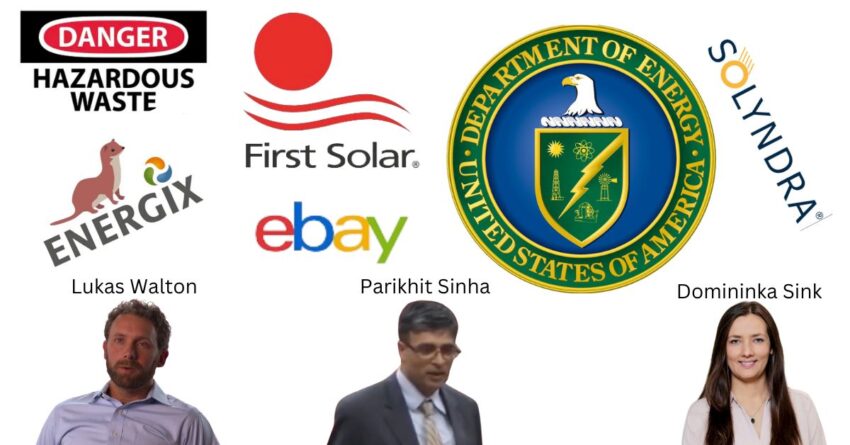Is First Solar the next Solyndra?
The 2011 bankruptcy of thin film solar energy manufacturer Solyndra two years after former Vice President Joe Biden announced $535 million in loans in 2009 plagued the Obama administration’s legacy and raised questions about Department of Energy oversight of U.S. renewable energy projects. As midterm elections approach this year, some prominent Republicans continue to campaign that there are other major “green energy boondoggles” hatched under President Joe Biden’s watch.
Solyndra blamed its demise on an 89 percent decline in the price of polysilicon, the common raw material used to manufacture most solar panels. Plunging fossil fuel prices also meant Solyndra’s tubular thin film technology could not compete with lower cost energy producers.
The demise of Solyndra did not slow other federal investments in risky thin film technology. In 2011 the Department of Energy guaranteed $1.24 billion in loans to construct the Desert Sunlight Solar Farm on a Bureau of Land Management site in California’s Mojave Desert. Desert Sunlight utilized flat Cadmium Telluride (CdTe) glass laminated panels manufactured by First Solar.
Unlike polysilicon, which represents 95 percent of worldwide solar panel manufacturing, CdTe is classified as a toxic substance by the Environmental Protection Agency that states it is harmful if swallowed, harmful to the skin, harmful if inhaled, and harmful to aquatic life. Cadmium is a toxic heavy metal waste byproduct of Zinc mining, smelting, and refining that would go into toxic waste sites if not utilized for PV panels. In Europe, First Solar was compelled to offer a pre-paid recycling contract paid by solar utility operators to ensure proper end-of-life return and recycling. Then Europe passed mandatory e-waste recycling regulations that made such practices applicable industry wide.
The US has no such regulations at the federal level, and state oversight is mostly non-existent.
What to do about e-waste from fully degraded First Solar panels has not slowed the flow of taxpayer funding into the company, which is self-proclaimed as America’s largest solar panel manufacturer. On May 17, 2020, First Solar was awarded another $3.73 billion in federal funds for three power plants in California. This timely cash infusion helped First Solar pay to end a $370 million shareholder lawsuit that alleged the company had provided misleading information to investors about its technology.
On December 7, 2021, the Development Finance Corporation (DFC) provided another $500 million in debt financing to First Solar to build a manufacturing facility in Tamil Nadu, India. In 2020, First Solar manufactured 65 percent of its panels overseas, mostly in Malaysia and Vietnam, although it touts itself as an American producer.
But clouds are forming over First Solar’s panels. Another group of shareholders are gathering for a lawsuit that alleges that First Solar’s Series 6 module was also not commercially ready when it was released.
In January of this year, Republicans on the House Committee on Oversight and Reform began probing whether Walmart heir Lukas Walton’s $300,000 contribution to President Joe Biden’s election campaign influenced the half billion dollar DFC loan. In 2020, Lukas Walton owned up to 22.5 million shares in First Solar.
First Solar’s biggest challenge may be American county governments that determine whether solar utilities can obtain permits to operate in rural areas. The Israeli renewable energy company Energix, a UNHCR listed human rights violator that the Virginia Israel Advisory Board is incubating, committed to purchasing $120 million in First Solar panels prior to fully entering the Virginia market. Energix has also been the beneficiary of lavish federal support in the form of solar energy tax credits and PPP loans.
On September 27, 2022, the Caroline County Virginia board of supervisors shot down Energix’s application for a permit to build a 12 megawatt solar utility on agricultural land. Although Energix representatives repeatedly insisted they “could” recycle panels under a confidential master services agreement with First Solar, the board of supervisors noted that Energix was simultaneously saying in other Virginia projects, such as Caden Energix Hickory LLC in Chesapeake, that partially degraded panels could instead be sold off to purchasers on Ebay.

Virginia’s Louisa and Caroline counties require periodic water and soil testing at CdTe sites while four other Virginia counties now forbid CdTe panels.
Parikhit Sinha, Director of Sustainable Development at First Solar, in 2019 publicly testified that First Solar could recycle its CdTe panels at a cost of $10 to $15 per unit although there is no independent confirmation of his claim. First Solar’s 2022 Sustainability Report reveals that the company is not yet capable of separating and refining out CdTe and must outsource the complex chemical breakdown process to third parties.
First Solar has not responded to multiple secondary market purchaser requests for recycling sent to the “recycling@firstsolar.com” email address listed on the back of its panels. It is highly likely that secondary owners of used panels will simply rip off the “non-household waste” labels affixed to the rear of the panels and dump the panels in the nearest landfill. This looming and unaccounted for e-waste bill, like Solyndra’s comparative cost issue, could be First Solar’s fatal comparative disadvantage.
In 2015, 200,000 CdTe panels at Desert Sunlight were shattered by the weakest category of tornado that ravaged the site, and they had to be trucked away and treated as toxic waste. The site operator and the Bureau of Land Management to this day refuse to publicly release the Toxicity Characteristic Leaching Procedure (TCLP) report performed after the Mojave disaster.
At 8.8 million CdTe solar panels, the future recycling cost of Desert Sunlight could be $88-132 million according to the Sinha estimates. This is an unfunded cost that was likely never built into the project and that could be paid by the same US taxpayers originally tapped to pay for site construction. Similarly, if all proposed Energix projects were presently online, the unfunded future recycling cost could approach $24-$37 million. Again, to date, not a single First Solar recycling contract has been presented by Energix in its many public hearings before county stakeholders.
Because Solyndra was doomed by its uncompetitive high costs, First Solar appears to have learned it must completely externalize its high product lifecycle costs by saddling operators with responsibility for e-waste. Market analysts pin 2012 as the year First Solar made that decision. The total cost is not insignificant. According to Sinha, there are now 200 million First Solar CdTe panels installed, and no site has ever been fully decommissioned. Under his own cost estimates, that represents a $2-$3 billion unfunded liability that could be paid for by unsuspecting property tax payers situated in rural counties.
Counties across America may find out the hard way that many operators utilizing First Solar panels are limited liability companies (LLCs) that may simply walk away from their utilities in 20-30 years. That may leave county taxpayers and property owners who leased land to operators like Energix on the hook for millions in recycling costs.
This is a situation entirely created by First Solar. First Solar touts its heavy involvement in early stage operations and in management of solar utilities, often using its low cost of capital to take the initial direct financial stake and to set up the LLCs before it transfers off fully built out sites (and all liability) to thinly capitalized long-term operators.


